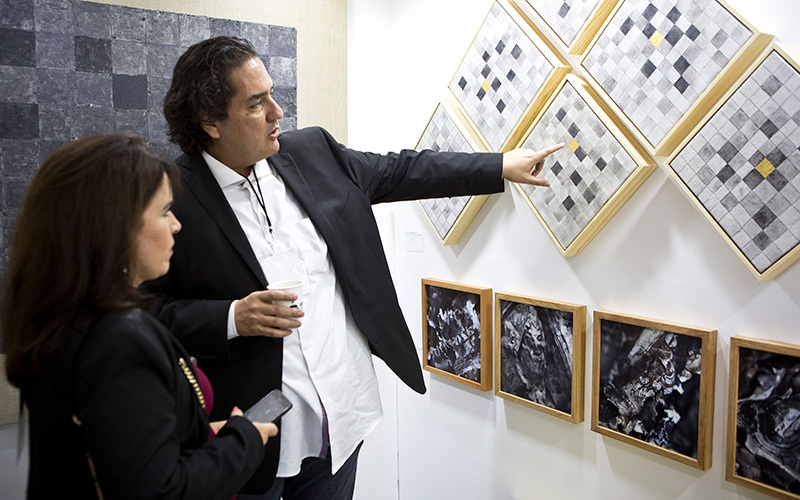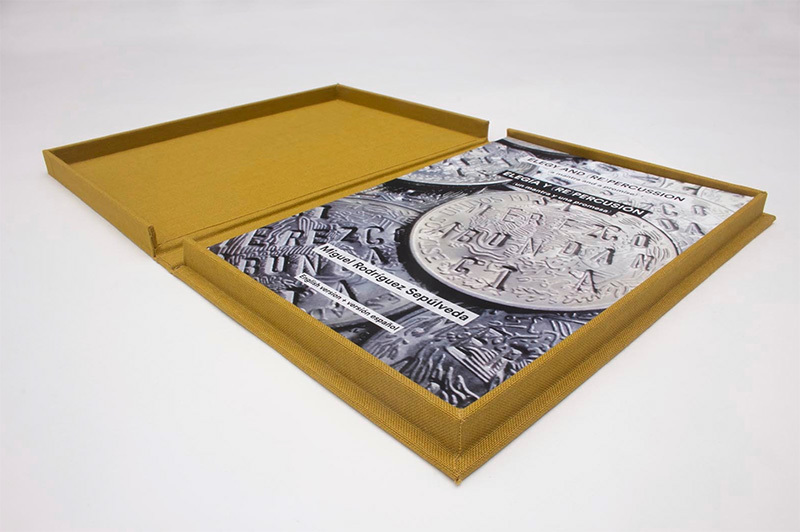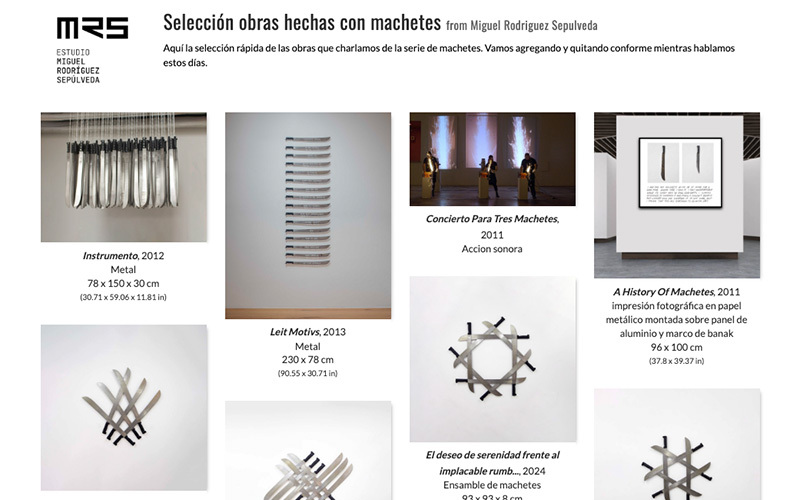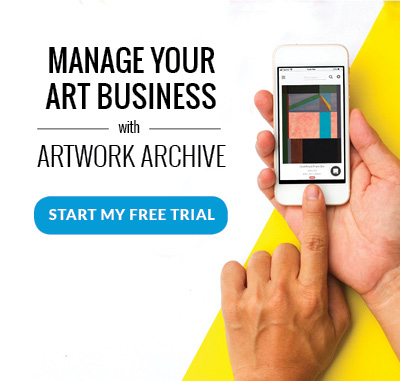 For Miguel Rodríguez Sepúlveda, the machete is a tool, a weapon, and a symbol.
For Miguel Rodríguez Sepúlveda, the machete is a tool, a weapon, and a symbol.
"Curiosity and perseverance have always driven me."
Based in Monterrey, Mexico, Featured Artist Miguel Rodríguez Sepúlveda has carved out a creative career by following his obsessions, wherever they may lead him. Trained as an engineer, he approaches many of his artworks through the mathematical and scientific principles that have shaped his worldview.
Whether he’s working with machetes, coins, or performances, his ultimate aim is to create the images he feels are missing in everyday life. To do that over many years, with as few creative restrictions as possible, is his ultimate goal.
“The deepest success lies in being able to continue creating with meaning and freedom over time.”
Patience and joy have guided Miguel Rodríguez Sepúlveda's lifelong creativity. Read on to learn how he has put this artistic philosophy into action, and the tools he has carefully chosen to reduce business distractions and keep him focused on what really matters.
 Miguel's creativity begins with the notebooks he has filled for over two decades.
Miguel's creativity begins with the notebooks he has filled for over two decades.
The Notebooks That Fuel Miguel’s Art
For more than twenty years, Miguel has been keeping daily records in his notebooks. Thick with sketches and writing, these books are filled with the phrases, concepts, diagrams, and drawings that pop into his consciousness.
“My work with these notebooks is not linear,” he tells Artwork Archive. “I constantly return to previous pages and to notebooks from past years to reread or add new notes over old ones.”
His source material may be what he reads or observes in the world, but it all gets processed through the imaginative entries in these notebooks.
He doesn’t worry too much about whether an idea is useful or not. He just notes it down in his notebooks, trusting that eventually a way forward will reveal itself: “Ideas gradually complete, connect, and mature until that ‘Eureka!’ moment appears, when something clicks and becomes the starting point for a new piece.”
Many of his series have been “officially closed” multiple times, only for him to reopen them when he discovers fresh angles worth exploring. That jump between a new way of looking at a problem and a fully realized art piece is at the core of his practice.
“I’m interested in the moment when thought becomes embodied, when an idea turns into matter, action, or symbol,” he shares.
Projects are always shifting and morphing into something new based on how Miguel’s own practice grows. But that’s by design.
“Some projects have evolved for over twenty years, intermittently and intertwined. Perhaps they are less projects than lifelong obsessions,” he reflects, “and I’m still coming to terms with that.”
 Miguel's notebooks are his places to record thoughts, daydream, and experiment with new paths.
Miguel's notebooks are his places to record thoughts, daydream, and experiment with new paths.
Turning Machetes Into Artworks
Miguel’s calm art-making process is methodical and analytical—a way of working that emerged naturally from his background.
“I studied a high school program specializing in physics and mathematics, and later began a degree in engineering,” he recalls. “It was precisely at that moment—when my way of seeing and understanding the world was shaped by mathematical and scientific principles—that I decided to devote myself to art.”
When he began creating his first works, scientific and mathematical approaches provided useful tools and references for thinking about his art. He now considers artistic questions like a mathematician examining a proof, interested in the ways symbols can combine and transform.
“I choose materials for their symbolic potential rather than their material value,” he explains. “I’m interested in how an everyday object can hold layers of history, desire, or collective memory.”
 Miguel Rodríguez Sepúlveda, Instrumento, 2012
Miguel Rodríguez Sepúlveda, Instrumento, 2012
One symbol he has taken up repeatedly in his work is the humble machete. He has photographed machetes, rendered them in watercolor and drawings, and created installations and sculptures using this utilitarian form—one that carries such different meanings depending on context.
“The machete attracts me because of its triple condition: a tool, a weapon, and a symbol of justice and social struggle,” he says. “That ambiguity allows me to speak about power and territory.”
He has also repeatedly used another ubiquitous material for many of his artworks, one that transforms from base material into a placeholder for abstract wealth: coins. With his coin pieces, he’s exploring value, exchange, and the fragile systems that give meaning to both.
Yet more than transforming these materials, he clarifies, “I’m interested in listening to them and letting them dialogue with one another,” and seeing “how an everyday object can hold layers of history, desire, or collective memory.”
 Miguel Rodríguez Sepúlveda, Cuño Corriente, 2009
Miguel Rodríguez Sepúlveda, Cuño Corriente, 2009
Art Is a Marathon, Not a Sprint
Over the years of letting projects gestate and evolve, Miguel has learned that time is also a vital element in his art practice. He has tried to let this appreciation of the long-term shape everything about his practice.
“For me, the most important mindset shift was learning to sustain and deepen ideas to their ultimate consequences,” he recalls. “To take them as far as possible—exhausting them, exploring every angle and possibility, letting them rest, and then rediscovering more in the same place.”
This philosophy applies to his artistic research as much as it does to managing his studio. “I like to think of my investigations and artistic paths as an endless race that I run simply because I enjoy running,” he shares. “Along that race there are exhibitions, books, residencies, interviews, production grants, awards, and other satisfactions that I see as stations along the way—very rewarding ones, no doubt—moments to breathe, recharge, celebrate, and continue.”
Even though it’s easy to be tempted by these exciting stations along his race, “ultimately, love for the journey itself is what truly matters.”
The goal for any project, in his mind, is not to finish it as quickly as possible, but to draw out all the possibilities that it may present. Savor the experience of creating itself, Miguel advises, and you’ll set yourself up for a life of exploration and satisfaction.
 Scenes from one of Miguel's performances using machetes.
Scenes from one of Miguel's performances using machetes.
Learning the Business of Art
Miguel is the son of merchants, and he grew up in the family business. But even with that background, learning how to run his art business sustainably took a lot of trial and error.
“Everything that involves managing my studio as a business has been a difficult learning process,” he admits. “The easiest part is focusing entirely on the artwork, but over time you realize that—no matter how strong the creative results are—without the effort of showing your work to the public, it’s hard for anything to leave the studio.”
A lot of artists face this conundrum: you want to spend as much time as possible creating your work, but you also know that you need revenue and regular exhibition opportunities to keep your practice afloat.
Miguel’s solution has been to give the management side of his art career the same kind of attention as the creative aspect of it.
“In my case, my studio is divided into two parts: ‘the workshop,’ where I make my art, and ‘the office,’ where all the paperwork happens,” he lays out for Artwork Archive. “Two versions of myself work side by side—each with different but indispensable tasks—that allow me to keep running my path, which is what I love most.”
In the early years of his career, Miguel made do with keeping his inventory spread across different spreadsheets and text files. But over time he ended up with countless different versions of the same information, one for every exhibition, sale, or loan, and no way of figuring out which one was actually accurate.
“It became a nightmare on my computer,” he remembers.
He had a big break with a group exhibition at one of the most important galleries in Mexico, and he noticed how polished all their reports and communications looked. He asked them what they used to manage their inventory, and that’s when he discovered professional inventory software.
After comparing the features and prices—some of which were “extremely expensive”—he finally found Artwork Archive. “It had exactly what I needed at a price I could afford,” he was excited to find. “I signed up immediately, and since then it has been a huge relief.”
Artwork Archive has finally given him the tools he needs to have one streamlined, functional system tracking all of his art business needs.
“Artwork Archive has allowed me to keep my inventory organized, record information about my artworks, exhibitions, and collectors, and—most importantly—feel that the administrative side of my practice is finally in order.” —Miguel Rodríguez Sepúlveda
 Now that Miguel has his art admin tasks under control, he can focus on what really matters to him: sharing his work with the world.
Now that Miguel has his art admin tasks under control, he can focus on what really matters to him: sharing his work with the world.
The Tools That Make Miguel’s Art Business Run Smoothly
Now that he has his inventory up and running in Artwork Archive, he’s able to make use of the richly capable suite of tools the platform provides to working artists.
“Private Rooms are extremely helpful,” he says. “They allow me to easily share a link and update the selection of works as I discuss them with the recipient.”
Plus, since he doesn't have to create each Private Room from scratch, he has freed up his headspace to be present for his clients: “It’s a huge time and effort saver, letting me focus on the conversation itself—which I really value.”
He also regularly uses Reports to create professional documents to share his work with his audience. “Selecting several pieces and exporting them to PDF in seconds is incredibly useful,” he offers.
He has found that he can easily filter his work by different subjects, tailoring his report to the interests of whoever he’s sending the report to: “I used to spend hours putting together a selection for a collector, museum, or curator, and now, with just a few clicks, it’s ready. Just like that.”
Presentations That Impress: Private Rooms
With Artwork Archive's Private Rooms, you can create custom presentations of your work, filtered by medium, size, theme, or any other category, perfectly tailored for your audiences. See how they can make connecting with clients easier than ever.
Advice For Young Artists
The key to Miguel’s creative longevity comes down to something basic: he’s willing to make mistakes, and he’s willing to pursue the avenues that interest him even if there doesn’t seem to be an immediate application for it.
“I’ve met artists who put pressure on themselves not to make mistakes, and I believe they miss an essential part of experimentation,” he advises. “Making mistakes is a fundamental part of discovering new territory.”
Making mistakes and pursuing his true interests have let him stay engaged and fascinated by what he creates in the studio. You won’t be making art for long if you chase fads that don’t kindle your own internal fire.
“Above all, cultivate consistency and patience,” he urges. “See your artistic career as a marathon, not a sprint.”
 Miguel Rodríguez Sepúlveda, Elegía y (re)Percusión (un mantra y una promesa), 2021
Miguel Rodríguez Sepúlveda, Elegía y (re)Percusión (un mantra y una promesa), 2021
What would change for you if you started thinking of your art career as a marathon, not a sprint? Taking the time to get your business side in order can give you the peace you need to be fearless in your art. A bit of structure now can mean more time and headspace for the work you actually want to be doing.
Artwork Archive helps artists build an online portfolio, stay on top of their inventory, and create things like tear sheets and invoices in just a few clicks. Start a free trial and see how it fits into your own process.






